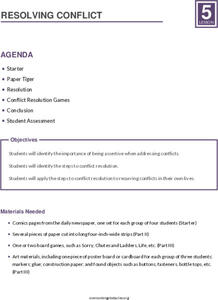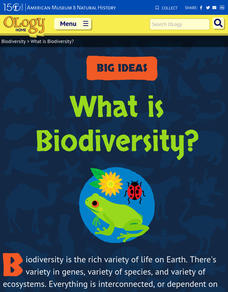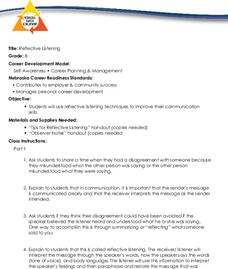Overcoming Obstacles
Resolving Conflict
Win-lose, lose-lose, or win-win? The final lesson in the "Resolving Conflict Module" brings together all that participants have learned in the module. They first list and prioritize the steps in conflict resolution, then develop a plan...
Overcoming Obstacles
Exploring Alternatives and Considering Consequences
Before making important decisions, it's imperative to consider alternatives and the possible consequences of choices. The third lesson in the fallout shelter activity begins by asking participants to consider the possible positive and...
Overcoming Obstacles
Managing Your Time
Wouldn't it be great to have a device that would stop time for everyone else but would let you catch up? Alas, there is not such a device yet. However, there is a way to make every minute count. That's the big idea in a lesson about time...
Overcoming Obstacles
Controlling Emotions in Conflicts
"Stop! Think! and Cool Down!" Participants in the third lesson in the Resolving Conflicts module learn how to pause and reflect in stressful situations rather than react. The class generates a list of strategies that could help control...
Facing History and Ourselves
Fist to Five
A "Fist to Five" routine asks participants to indicate how they feel about an opening question, like how ready they are to start learning, how well they understand instructions, etc. Groups then suggest strategies to get learners ready...
Overcoming Obstacles
Formalizing and Finalizing the Action Plan
It's time to get to work! Groups assign roles, duties, and due dates for their Service Learning action plan. They then identify the approvals they will need to complete their project successfully.
American Museum of Natural History
Find My Plankton Baby Picture
Get a better understanding of babies in the sea. The class learns about the two kinds of plankton. They then determine the baby pictures of eight marine animals given a picture of the adult and some hints about the larvae. When scholars...
American Museum of Natural History
What is Biodiversity?
Not all dogs are the same just like not all finches are the same. An interactive online lesson helps individuals learn about the causes and limitations to biodiversity. The clickable sections describe the basics of the genetics of...
American Museum of Natural History
Talking to Fireflies
Fireflies are more than just mobile twinkle lights. An online interactive lesson teaches individuals about the light patterns fireflies use to communicate with each other. After they practice the patterns themselves, they could be...
Missouri Department of Elementary
Tic Tac Toe, Get Off My Toes
Why is conflict resolution such an important skill to learn? Pupils explore the topic, playing an adapted Tic-tac-toe game. Two class teams are tasked with finding a win-win solution to a hypothetical conflict before adding their X...
Missouri Department of Elementary
Communicating with I-Messages (2/2)
Class members read a handout to learn about using I-Messages—honest statements that begin with I to get their points of view across. Next, learners practice using I-Messages with partners to better communicate without hurting...
California Department of Education
What’s the Market for My Labor?
A lesson showcases how knowing about Labor Market Information (LMI) supports searching for future job opportunities. Following a review of the concept and other vocabulary terms, scholars research occupations and answer questions on...
Curriculum Corner
Literacy Center Plans
When planning for your next learning stations or literacy center activity, use this resource as an outline for what will happen at each center, which students will be involved in each group, and how the small group activities will...
California Department of Education
Consonance and Dissonance: Creating Intervals for Emotions (CTE)
How are music and emotion related? Using lesson plan two of four from the Changing One's Tune: A Music Therapy STEM Integrated Project Series, scholars explore the connection between the two topics. They learn to recognize different...
Healthy Native Youth
Chapter 4: Learning About Disease
Communicable diseases are the focus of a instructional activity that primarily uses discussion, a hands-on activity, and a worksheet to drive their point home. Lotion and glitter create a strong visual for communicable diseases. A...
Health Smart Virginia
Shake It Off
It requires more than a twitch to shake off stress. But with the help of the stress management strategies taught in a very dynamic activity, freshmen can learn to do so. Class members watch videos, examine an infographic, read an...
Health Smart Virginia
Stress Management - Doctor Disease
Doctor, doctor, help me please! As part of their study of the correlation between disease and illness, middle schoolers take on the role of doctors. They rotate through 10 learning stations, read about patients' symptoms, and write a...
Newseum
Civil Rights: The Five Freedoms
After a close reading of the First Amendment and the five freedoms it guarantees, class members examine the civil rights timeline to see how civil rights groups applied these freedoms to create change. Using the issue the class chose in...
Nebraska Department of Education
Reflective Listening
Reflective listening is not casual! After learning about the practice of reflective listening, middle schoolers practice reflective listening skills in a role play activity that has them take turns being a speaker, listener, and observer.
Nebraska Department of Education
Goal Maps
High school freshmen are asked to think about their future goals and reflect on what they have learned about the barriers they may face and the resources they have to overcome these barriers. Individuals then respond to questions on a...
Overcoming Obstacles
Listening
The big idea in this resource is that listening and hearing are not the same things. A lesson on active listening has class members generate a list of listening techniques that focus on the speaker, confirm what they say, and respond...
Curated OER
How Do I Learn Best?
Students read about and determine their individual learning styles in order to develop learning strategies. They use a learning style inventory to find out their learning style and also to help choose helpful learning strategies.
Curated OER
Learning to Give
Students learn what it means to give generously. In this giving lesson plan, students give examples of when they have given of themselves. Students complete a service project where they create a gift for preschoolers with whom they can...
Curated OER
Proud to Be of Service
Observe the National Day of Service and Remembrance with a service learning lesson plan. After discussing the events of September 11, 2001, learners plan and implement their own service learning project in honor of American...
Other popular searches
- Project Based Learning
- Cooperative Learning
- Learning Disabilities
- Inquiry Based Learning
- Distance Learning
- Learning Styles
- Developmental Learning
- Discovery Learning
- +Developmental +Learning
- Learning 7 Continents
- Service Learning
- Learning Lesson Plans























